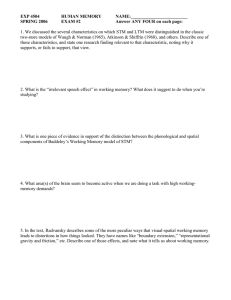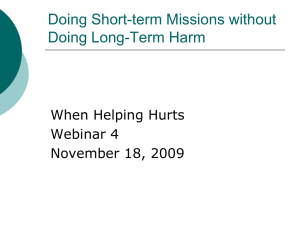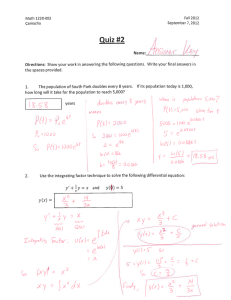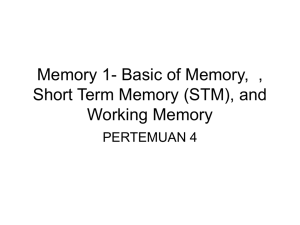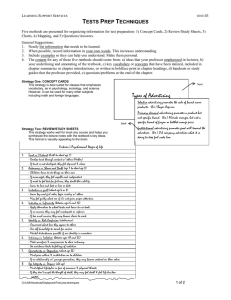Upcoming Reading •False Memories (Beth Loftus) •Lost Mariner (Oliver Sacks)
advertisement
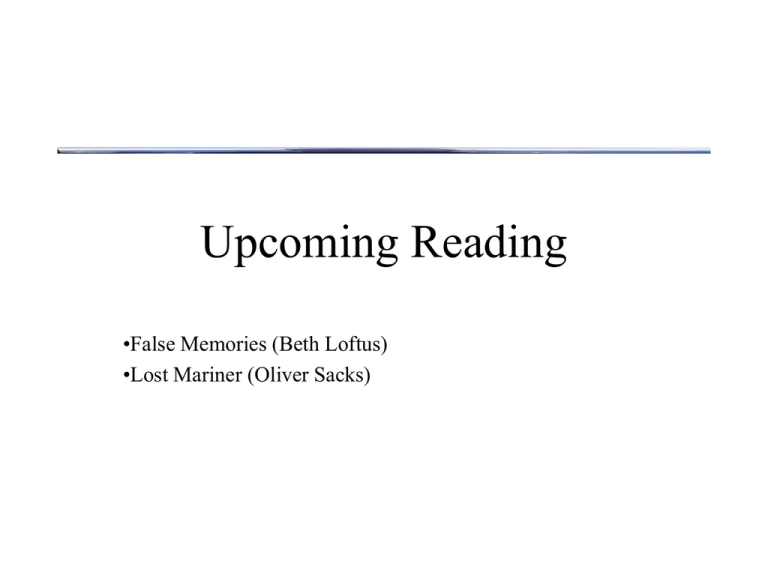
Upcoming Reading •False Memories (Beth Loftus) •Lost Mariner (Oliver Sacks) Extra Reading •Cognition on reserve in Library Overview of Memory RETRIEVAL • Atkinson-Shiffrin Model ATTENTION Sensory Signals Sensory Memory Short-Term Memory Long-Term Memory REHEARSAL “Types” of Memory • Sensory Memory – brief ( < 1 second) – preattentive / parallel processing (very large capacity) Sensory Memory Capacity • Describe a simple experiment that could measure the capacity of “memory” Capacity • Describe a simple experiment that could measure the capacity of “memory” • Briefly present some letters or digits and then ask the subject to report them – Called “whole report” Capacity + Capacity F S F E G S+ A U T O C G Capacity “Recall as many letters as you can” Capacity • George Sperling - Systematic investigation of memory capacity – Result: subjects accurately recall 3 or 4 items – What can you conclude from this result? Capacity • Could it be that subjects had encoded but failed to retrieve the information? Capacity • For example: what if recalling interferes with memory? • How could you modify the experiment to measure the instantaneous capacity, before any forgetting can occur? Capacity • Partial Report - briefly present letters or digits and ask subject to report only some of them “Report the letters in the row indicated by the arrow” Capacity + Capacity U E S B O D+W A I B V S Capacity + Capacity + Capacity Which Letters? Capacity • Partial Report • Result: subjects can recall any 3 or 4 letters that are indicated by the arrow ! Capacity • Partial Report • Result: subjects can recall any 3 or 4 letters that are indicated by the arrow ! • What does this mean about the capacity of memory? Capacity • There is some part of the perception system that stores huge amounts of information… – in fact, if only a single letter is probed, instantaneous capacity is seen to be unlimited Duration • There is some part of the perception system that stores huge amounts of information… • But for how long? How would you design an experiment to measure the duration of this high-capacity memory system? Duration • There is some part of the perception system that stores huge amounts of information… • But for how long? How would you design an experiment to measure the duration of this high-capacity memory system? • Vary the onset of the probe Duration • Partial Report # of letters potentially recalled 10 4 0 0 ms 500 ms never Probe Delay Duration • Partial Report 10 # of letters potentially 4 recalled 0 0 ms 500 ms Delay never Interpretation: 1. Information dwells in a brief storage “buffer” 2. duration of storage lasts about 1/2 of one second Iconic Memory • a brief storage of “raw data” in the visual system Echoic Memory • Auditory information is stored in a similar sensory “buffer” – Echoic memory seems to last for several seconds Properties of Sensory Memory 1. Brief (iconic ~500ms; echoic ~2 seconds) Properties of Sensory Memory 1. Brief (iconic ~500ms; echoic ~2 seconds) 2. Virtually unlimited capacity Properties of Sensory Memory 1. Brief (iconic ~500ms; echoic ~2 seconds) 2. Virtually unlimited capacity 3. pre-attentive Overview of Memory RETRIEVAL • Atkinson-Shiffrin Model ATTENTION Sensory Signals Sensory Memory Short-Term Memory Long-Term Memory REHEARSAL Short-Term Memory • process by which we hold information “in mind” Short-Term Memory • process by which we hold information “in mind” • example: temporarily remembering a phone number Characteristics of STM • Duration? Capacity? • How could one measure these parameters? Characteristics of STM • Limited Duration – Brown-Petersen Task: • subject is given a trigram (e.g. C-F-W) to remember • vocal rehearsal is prevented by counting backwards • recall accuracy tested as a function of retention interval Characteristics of STM • STM decays over seconds Characteristics of STM • Limited Duration – Brown-Petersen Task Interpretation: rapid loss of information in STM (over a period of seconds…much longer than sensory memory) Characteristics of STM • Limited Capacity – How might you measure capacity? Characteristics of STM • Limited Capacity – – George Miller Subject is given longer and longer lists of tobe-remembered items (words, characters, digits) Characteristics of STM • Limited Capacity – – – George Miller Subject is given longer and longer lists of tobe-remembered items (words, characters, digits) Result: Subjects are successful up to about 7 items Characteristics of STM • Limited Capacity – What confound must be considered ?! Characteristics of STM • Limited Capacity – – What confound must be considered ?! Recalling takes time ! Characteristics of STM • Limited Capacity – – – – What confound must be considered ?! Recalling takes time ! It seems that the “capacity” of STM (at least measured in this way) depends on the rate of speech - faster speech leads to apparently larger capacity Some believe capacity is “2 - 3 seconds worth of speech” Forgetting from STM • Why do we “forget” from STM? – Does the memory trace decay? • not likely because with very small lists (like 1 item) retention is high for long intervals Forgetting from STM • Why do we “forget” from STM? – Does the memory trace decay? • not likely because with very small lists (like 1 item) retention is high for long intervals – Instead, it seems that information “piles up” and begins to interfere Forgetting from STM • Interference in STM is complex and specific Forgetting from STM • Interference in STM is complex and specific • For example, severity of interference depends on meaning Forgetting from STM • Interference in STM is complex and specific • For example, severity of interference depends on meaning – Subjects are given successive recall tasks with list items from the same category (e.g. fruits) – final list is of either same or different category how is good is recall on this list? Forgetting from STM • Accuracy rebounds if category changes Coding in STM • How is information coded in STM? Coding in STM • Clues about coding in STM: – # of items stored in STM depends on rate of speech Coding in STM • Clues about coding in STM: – # of items stored in STM depends on rate of speech – phonological similarity effect: similar sounding words are harder to store/recall than different sounding words Coding in STM • Clues about coding in STM: – # of items stored in STM depends on rate of speech – phonological similarity effect: similar sounding words are harder to store/recall than different sounding words What does this suggest about the nature of information in STM? Coding in STM • It seems that information can be stored in a linguistic or phonological form Coding in STM • It seems that information can be stored in a linguistic or phonological form Must it be stored this way? Coding in STM • It is also possible to “keep in mind” nonverbal information, such as a map Are there two different STM systems? A Modular Approach to STM Central Executive Articulatory Loop Visuospatial Sketchpad Experiment 1 in the article by Lee Brooks demonstrates a double dissociation between Articulatory Loop and Visuospatial Sketchpad Working Memory “Modules” • Lee Brooks: interference between different representations in STM (Experiment 1) – Memory Representation • verbal task: categorize words in a sentence • spatial task: categorize corners in a block letter – Response Modality • verbal response: say “yes” or “no” • spatial response: point to “yes” or “no” Working Memory “Modules” • result: Performance Verbal Representation (categorize words) Spatial Representation (categorize corners) Verbal Spatial Response Modality Working Memory “Modules” • Interpretation: – supports notion of modularity in Working Memory (visuospatial sketchpad / articulatory loop)
